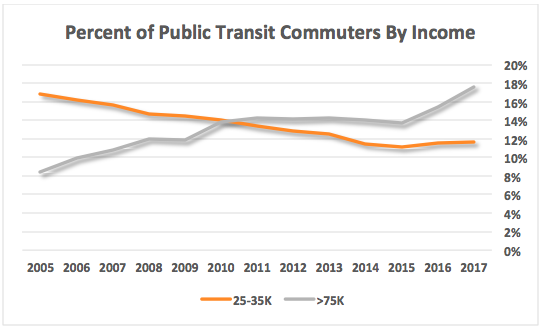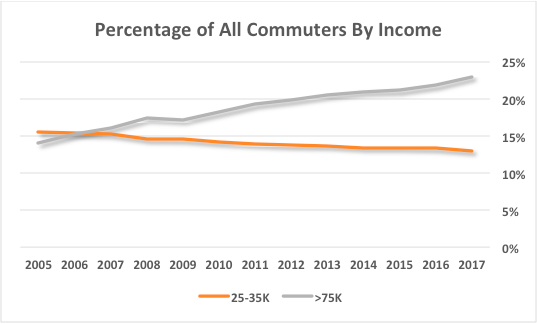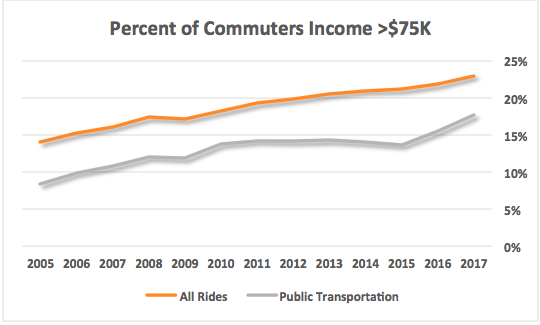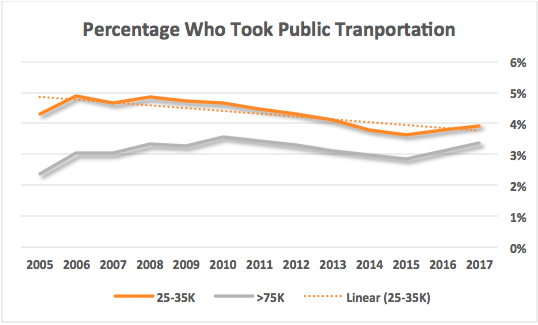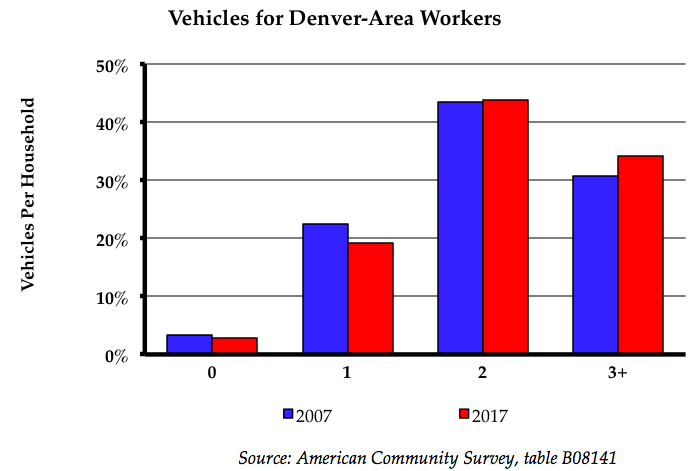Public transportation used to be sold as a means of helping commuters without cars, or for whom driving was prohibitively expensive, get to their jobs. It was seen as a means of providing mobility to some on the bottom or lower-middle rungs on the economic ladder, largely paid for by those who were busy trying to climb the higher rungs.
Increasingly, however, metropolitan bus and rail service are used by upper- and upper middle-class wage earners, subsidized through taxes disproportionately paid by lower- and lower middle-class families. For Denver area commuters, this change has occurred even as total ridership has stagnated, and massive amounts of money have been poured into light rail.
The idea was first suggested by data from Randal O’Toole’s invaluable and comprehensive spreadsheet of nationwide transit data. For transit use by income, O’Toole references the Census Bureau’s American Community Survey. From 2007-2017, even as Denver and Aurora’s combined median income has edged up from $41,800 to $43,200 in 2018 constant dollars, the median income of its transit commuters has increased from $31,900 to $37,100.
The change has largely been driven by huge growth of transit commuters making more than $65,000 per year (from 7,500 to 17,500 daily) and a drop in use by those making less than $15,000 per year. Even as the population has grown, use by those in the middle has grown only slightly.
To get a slightly more comprehensive view, we used the same source, going back to 2005 for Adams, Arapahoe, Denver, Douglas, and Jefferson counties, adding Broomfield in 2007. We chose to focus on two income bins – high earners, earning more than $75,000, and medium-low earners, earning $25-35,000.
We began by looking at the composition of those on public transit by income, meaning if you pick a random commuter who’s already on public transit, how likely is it they’re in one of these income groups. The change from 2005 to 2017 is striking:
Compared to 2005, if you’re on RTD, you’re significantly less likely to encounter someone earning a lower middle-class income, and significantly more likely to encounter someone earning an upper-class or upper middle-class income.
Some of this is because any commuter is more likely to be higher income:
Indeed, if you take the >$75K lines from the above two charts, it appears that the new arrivals to the Denver area who are high-earners are more likely to take public transportation:
However, these numbers need to be kept in context of overall commuting. They may be more likely to take public transit, but they’re still a tiny percentage of commuters overall:
Fewer than 1 in 25 commuters is on public transit to begin with. What’s more, if you’re making more than $75,000, you’re not really any more likely to take public transportation than you were in 2006 or 2007, it’s just that the new rail and bus routes are proportionately more likely to be convenient for you.
On the other hand, if you’re making between $25-35,000 a year, you’re about 20% less likely to be taking a bus or a train to work than you were in 2006.
The injustice here is that RTD is about 80% funded by a 1% sales tax surcharge. Everyone, from the Heritage Foundation on the right to Brookings and the Urban Institute on the left, agrees that sales taxes are regressive, even when they include exceptions for things like food and clothing.
Increasingly, people who are making less money are subsidizing the comfortable train rides of people who make comfortable livings. Like electric vehicle charging stations, wind power, household solar, and numerous other social engineering projects, RTD is increasingly transferring wealth from the poor to the well-off.
None of this should be terribly surprising. Recently, the rhetoric behind public transportation has shifted from giving options to people who can’t afford one car per adult to “getting people out of their cars.” To do that, you have to focus your service on people who already have cars. The problem is that people who don’t have enough cars will find a way to buy them:
The net result? Public transit isn’t getting anyone out of their cars – people are just about as likely to drive alone now as they were a decade ago:
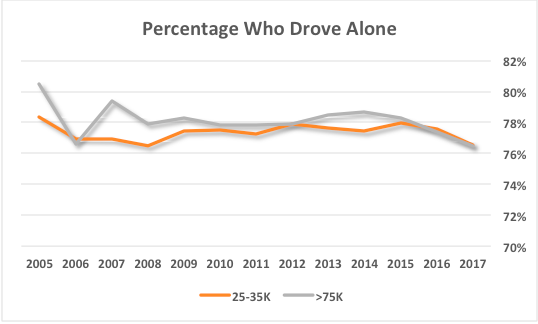 Joshua Sharf is a fiscal policy analyst at the Independence Institute, a free market think tank in Denver.
Joshua Sharf is a fiscal policy analyst at the Independence Institute, a free market think tank in Denver.

